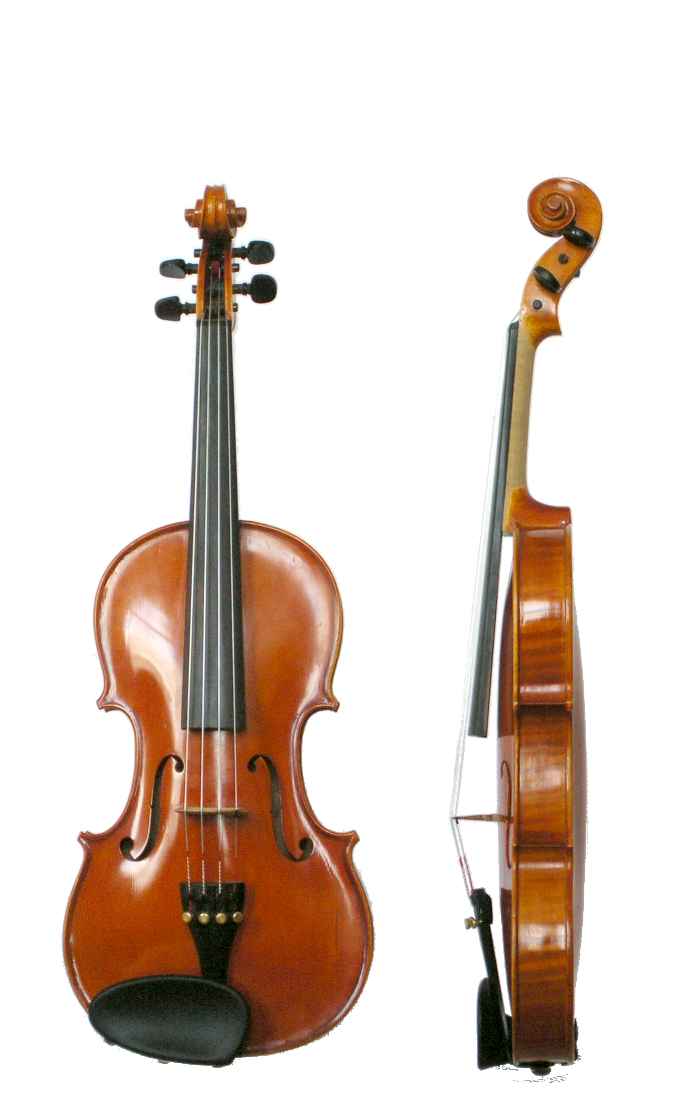The violin is a bowed string instrument with four strings usually tuned in perfect fifths. It is the smallest and highest-pitched member of the violin family of string instruments, which also includes the viola and cello.
The violin is sometimes informally called a fiddle, regardless of the type of music played on it. The word "violin" comes from the Middle Latin word vitula, meaning "stringed instrument"; this word is also believed to be the source of the Germanic "fiddle". The violin, while it has ancient origins, acquired most of its modern characteristics in 16th-century Italy, with some further modifications occurring in the 18th century. Violinists and collectors particularly prize the instruments made by the Stradivari, Guarneri and Amati families from the 16th to the 18th century in Cremona.
Germanic "fiddle". The violin, while it has ancient origins, acquired most of its modern characteristics in 16th-century Italy, with some further modifications occurring in the 18th century. Violinists and collectors particularly prize the instruments made by the Stradivari, Guarneri and Amati families from the 16th to the 18th century in Cremona.
A person who makes or repairs violins is called a luthier, or simply a violin maker. The parts of a violin are usually made from different types of wood (although electric violins may not be made of wood at all, since their sound may not be dependent on specific acoustic characteristics of the instrument's construction), and it is generally strung with gut or steel strings.
Someone who plays the violin is called a violinist or a fiddler. He or she produces sound from a violin by either drawing a bow (normally held in the right hand) across one or more strings (which may be stopped by the fingers of the other hand to produce a full range of pitches), plucking the strings (with either hand), or a variety of other techniques. The violin is played by musicians in a wide variety of musical genres, including Baroque music, classical, jazz, folk and traditional, and rock and roll.
The earliest stringed instruments were mostly plucked (e.g. the Greek lyre). Bowed instruments may have originated in the equestrian cultures of Central Asia, an example being the Mongolian instrument Morin huur:
Turkic and Mongolian horsemen from Inner Asia were probably the world’s earliest fiddlers. Their two-stringed upright fiddles were strung with horsehair strings, played with horsehair bows, and often feature a carved horse’s head at the end of the neck. ... The violins, violas, and cellos we play today, and whose bows are still strung with horsehair, are a legacy of the nomads.
It is believed that these instruments eventually spread to China, India, the Byzantine Empire and the Middle East, where they developed into instruments such as the erhu in China, the rebab in the Middle East, the bowed Byzantine lyra and the esraj in India. The violin in its present form emerged in early 16th-Century Northern Italy, where the port towns of Venice and Genoa maintained extensive ties to central Asia through the trade routes of the silk road.
The modern European violin evolved from various bowed stringed instruments which were brought from the Middle East and the Byzantine Empire. Most likely the first makers of violins borrowed from three types of current instruments: the rebec, in use since the 10th century (itself derived from the Arabic rebab), the Renaissance fiddle, and the lira da braccio (derived from the Byzantine lira . One of the earliest explicit descriptions of the instrument, including its tuning, was in the Epitome musical by Jambe de Fer, published in Lyon in 1556. By this time, the violin had already begun to spread throughout Europe.
The oldest documented violin to have four strings, like the modern violin, is supposed to have been constructed in 1555 by Andrea Amati, but the date is doubtful. (Other violins, documented significantly earlier, only had three strings.) The violin immediately became very popular, both among street musicians and the nobility, illustrated by the fact that the French king Charles IX ordered Amati to construct 24 violins for him in 1560. The oldest surviving violin, dated inside, is from this set, and is known as the "Charles IX," made in Cremona c. 1560. "The Messiah" or "Le Messie" (also known as the "Salabue") made by Antonio Stradivari in 1716 remains pristine, never having been used. It is now located in the Ashmolean Museum of Oxford.
To this day, instruments from the "Golden Age" of violin making, especially those made by Stradivari and Guarneri del Gesù, are the most sought-after instruments by both collectors and performers.
The violin is sometimes informally called a fiddle, regardless of the type of music played on it. The word "violin" comes from the Middle Latin word vitula, meaning "stringed instrument"; this word is also believed to be the source of the
 Germanic "fiddle". The violin, while it has ancient origins, acquired most of its modern characteristics in 16th-century Italy, with some further modifications occurring in the 18th century. Violinists and collectors particularly prize the instruments made by the Stradivari, Guarneri and Amati families from the 16th to the 18th century in Cremona.
Germanic "fiddle". The violin, while it has ancient origins, acquired most of its modern characteristics in 16th-century Italy, with some further modifications occurring in the 18th century. Violinists and collectors particularly prize the instruments made by the Stradivari, Guarneri and Amati families from the 16th to the 18th century in Cremona.A person who makes or repairs violins is called a luthier, or simply a violin maker. The parts of a violin are usually made from different types of wood (although electric violins may not be made of wood at all, since their sound may not be dependent on specific acoustic characteristics of the instrument's construction), and it is generally strung with gut or steel strings.
Someone who plays the violin is called a violinist or a fiddler. He or she produces sound from a violin by either drawing a bow (normally held in the right hand) across one or more strings (which may be stopped by the fingers of the other hand to produce a full range of pitches), plucking the strings (with either hand), or a variety of other techniques. The violin is played by musicians in a wide variety of musical genres, including Baroque music, classical, jazz, folk and traditional, and rock and roll.
The earliest stringed instruments were mostly plucked (e.g. the Greek lyre). Bowed instruments may have originated in the equestrian cultures of Central Asia, an example being the Mongolian instrument Morin huur:
Turkic and Mongolian horsemen from Inner Asia were probably the world’s earliest fiddlers. Their two-stringed upright fiddles were strung with horsehair strings, played with horsehair bows, and often feature a carved horse’s head at the end of the neck. ... The violins, violas, and cellos we play today, and whose bows are still strung with horsehair, are a legacy of the nomads.
It is believed that these instruments eventually spread to China, India, the Byzantine Empire and the Middle East, where they developed into instruments such as the erhu in China, the rebab in the Middle East, the bowed Byzantine lyra and the esraj in India. The violin in its present form emerged in early 16th-Century Northern Italy, where the port towns of Venice and Genoa maintained extensive ties to central Asia through the trade routes of the silk road.
The modern European violin evolved from various bowed stringed instruments which were brought from the Middle East and the Byzantine Empire. Most likely the first makers of violins borrowed from three types of current instruments: the rebec, in use since the 10th century (itself derived from the Arabic rebab), the Renaissance fiddle, and the lira da braccio (derived from the Byzantine lira . One of the earliest explicit descriptions of the instrument, including its tuning, was in the Epitome musical by Jambe de Fer, published in Lyon in 1556. By this time, the violin had already begun to spread throughout Europe.
The oldest documented violin to have four strings, like the modern violin, is supposed to have been constructed in 1555 by Andrea Amati, but the date is doubtful. (Other violins, documented significantly earlier, only had three strings.) The violin immediately became very popular, both among street musicians and the nobility, illustrated by the fact that the French king Charles IX ordered Amati to construct 24 violins for him in 1560. The oldest surviving violin, dated inside, is from this set, and is known as the "Charles IX," made in Cremona c. 1560. "The Messiah" or "Le Messie" (also known as the "Salabue") made by Antonio Stradivari in 1716 remains pristine, never having been used. It is now located in the Ashmolean Museum of Oxford.
To this day, instruments from the "Golden Age" of violin making, especially those made by Stradivari and Guarneri del Gesù, are the most sought-after instruments by both collectors and performers.




Hi! This is my first comment here so I just wanted to give a quick shout out and
RăspundețiȘtergeresay I truly enjoy reading through your posts. Can you
suggest any other blogs/websites/forums that go over the
same topics? Thanks!
Review my web site - high quality beats by dr. dre headphones